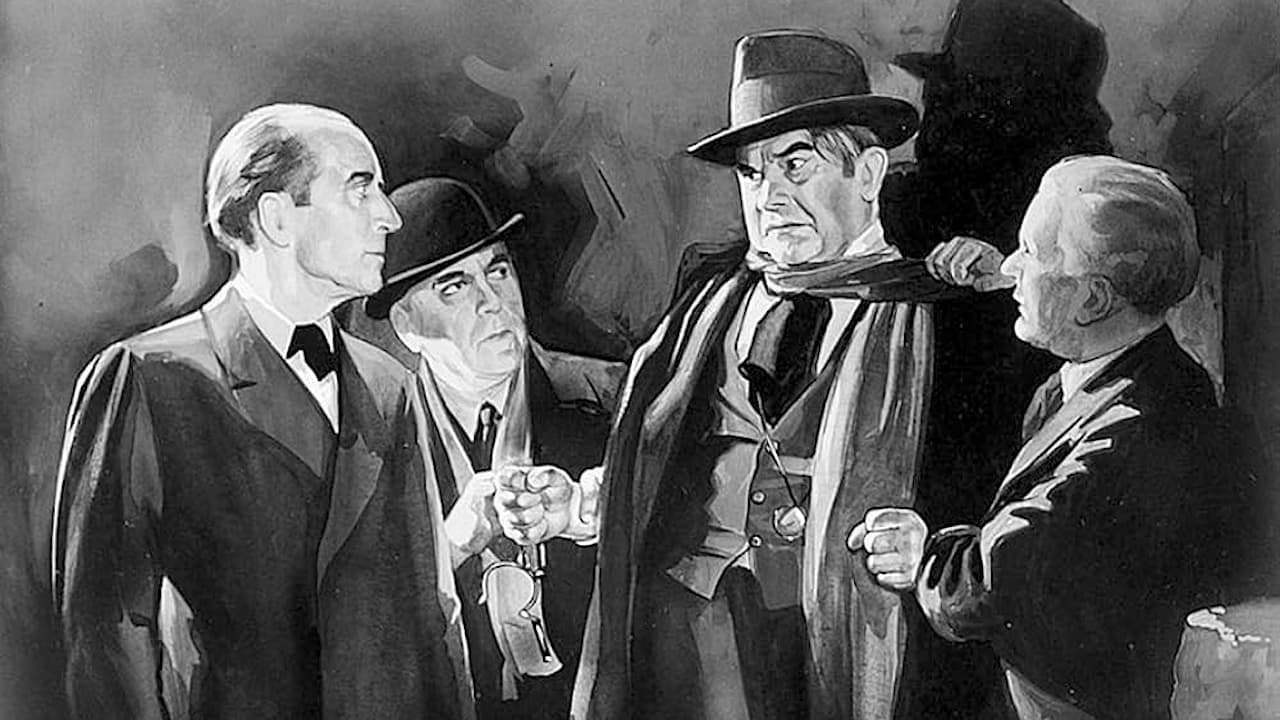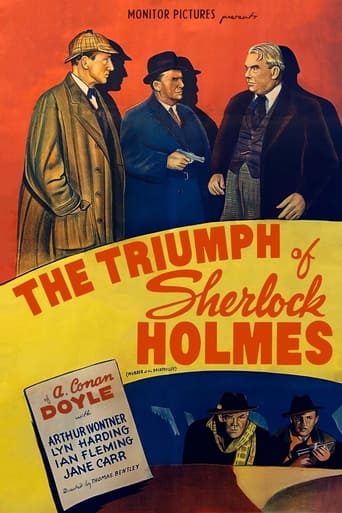


It's based on "The Valley of Fear," Conan-Doyle's last and least novella. Poor Conan-Doyle. He'd grown to dislike Sherlock Holmes. The character was a cash cow but had become Frankenstein's monster. And there is nothing more disgusting than a cow that is a monster except a mixed metaphor.Conan-Doyle had a much larger vision -- writing epic adventure stories. He did write some and a few were popular successes -- "The Lost World" -- but they didn't compare with Holmes. As time went by, Conan-Doyle put less effort into the Holmes stories. They lost their savour. In "The Triumph of Sherlock Holmes" with Arthur Wontner, we can see the result. This is a colorless Holmes -- no dope, no quirks, and some of the deductions are literally incredible.Wontner himself isn't that bad except when compared to Basil Rathbone or Jeremy Brett. Wontner simply isn't a commanding presence. It's too bad because more than any other Holmes he resembles the Sidney Paget illustrations that accompanied the original magazine stories.I suppose one of the ways that Conan-Doyle was able to satisfy his need to write exotic adventures was to insert flashbacks that took us to lands far away from 221b Baker Street. In "A Study in Scarlet" it was Mormons; here it's what seems to be the Wobblies in the Pennsylvania coal country. The back stories are frankly dull.The productions are adequate, no more than that. The set dressings don't look cheesy; they only look stagy. The performances fit into the same category. The most memorable figure is McGinty, the head honcho of the Scowrers, a giant of a man with a voice to match.
... View MoreThis is the second of the early Holmes film experiments that I have seen. In The Sign of Four, they messed up the detective form by showing us the entire history before Holmes appears. Here, they do something similar. While Holmes interviews a woman about her recently dead husband, we have the major part of the film time occupied in a flashback illustrating her story. That story is a small film by itself. The outer story is a combat between Moriarty and a *retired* Holmes that ends with a chase up a medieval tower with what might have been exciting camera-work in its day. This story does respect Holmes as a detective, and the task he tackles is not something we already understand. I can see that as they made extra films, they tried different mixes of explicit storytelling and deduced and explained stories.
... View MoreTRIUMPH OF SHERLOCK HOLMES stars British thespian Arthur Wontner, today a forgotten interpreter of Holmes who would soon be overshadowed by the glossy American productions starring the illustrious Basil Rathbone, for some people the greatest Holmes ever. Wontner is actually a terrific Holmes, and looks remarkably like the first illustrations of Holmes. Wontner also prepared the dialog for the movie, and sticks relatively close to the source material, in this case THE VALLEY OF FEAR. Ian Fleming's Dr. Watson is a lot closer to the Watson of the stories, a retired Army officer and dapper fellow with an eye for the ladies. Wontner and Fleming have a palpable chemistry and affectionate interplay that reminds me more of the Holmes and Watson of the original stories than most other cinematic Holmes and Watsons. If you don't know the plot of VALLEY, and I admittedly had forgotten, you will be kept guessing right up to the very end the identity of the killer. A word on Lyn Harding as Holmes' archfoe Moriarty: He is as good a Moriarty as I have ever seen on screen. What keeps me from giving this film an extra point is its primitiveness. By 1935, most films looked and sounded a lot better than this. Also, this is a "modern" Holmes adaptation; that is to say, Holmes has been moved forward in time to the present day, in this case 1935, which may save on costumes and sets, but slightly impairs the atmosphere. See it for its historical value, and also to see someone other than Rathbone tearing it up as the world's greatest detective.
... View More***SPOILERS*** Sherlock Holmes, Arthur Wontner, looking more like Gen. Douglas MacArthur minus his corn cob pipe, Sherlock puffs on his famous Calabash Bassoon in the movie like in all the other films that he's in, is hot on the trail of his archenemy the brilliant but diabolical Prof. Moriarty, Lyn Harding. In a tale of murder and deception in the movie "The Triumph of Sherlock Holmes". Sherlock retired from police work and living in the country tending his beloved bees and beehives is brought out of retirement when he gets a coded message from one of Prof. Moriarty's hoods.Pllock,about a murder thats about to be committed at the Birlstone Castle. Before Holmes can do anything to prevent the murder from happening he finds out from police inspector Lestrade, Charles Mortimer, that the owner of the Birlstone Castle John Douglas,Leslie Perrins, was murdered. Douglas had his head blown off with a shotgun the night before. Going with the police to the Birlstone Castle Sherlock Holmes checks out the murder scene to see if he can come up with any clues. Sherlock finds Douglas' wife Ettie, Jane Carr, a bit deceptive about her husband and feels that she's hiding something that can crack the case wide open for reasons only known to herself. Pressed by Sherlock Holmes Ettie tell him and the police the true story about her husband John and how she first met him. John Douglas is really an American hoodlum from Chicago named John Murdoc who she first met in the coal mining district of Pennsylvania called "The Valley of Fear". Murdoc was a member of a group of criminals called "The Scowlers" who terrorized the people in that area.Murdoc participated and committed a number of vicious crimes with "The Scowlers" in "The Valley of Fear" and in no time at all became one of the leading henchmen of the outfit run by Boss McGinty, Roy Emerson. One day Murdoc tells McGinty that there's a spy among them and that he'll lead them to him where they can shut him up for good.Going to this deserted house in the valley Murdoc tell McGinty & Co. that the spy's name is Bernie Edwards and in a moment he'll be coming over and that they can give Bernie a hot reception as soon as he shows up. Murdoc walking out of the house for a minute and then coming in tell the startled "Scowlers" that he's Bernie Edwards and that he's also a agent of the Pinkerton Detective Agency and that their all under arrest. With that the house is raided by the police and McGinty and his top henchmen including Ted Balding, Ben Welden, are arrested and the whole "Scowlers" gang is put out of business for good.Balding later escapes from prison and goes to England where he gets in touch with Prof. Moriarty to help him find Murdoc/Edwards and offers him $50,000.00 to do it. Balding learning from Prof. Moriarty that Murdoc/Edwards is now known as John Douglas and lives at the Birlstone Castle then sneaks into the castle to murder Douglas. It's then that Douglas turns the tables on him and blows Balding's head off with the shotgun that he had with him. Douglas then puts his wedding ring on Balding's finger and makes it look like it was him, John Douglas, that was murdered. In the end Prof. Moriarty goes to the castle at night to meet Balding, who he thinks is alive, to get his $50,000.00 reward that he offered him for finding out who the former Murdoc/Edwards is and where he could find him. With Sherlock Holmes and the police having set a trap for him Moriarty is chased up to the castle tower and then falls down into the moat and drowns. As the movie ends we see Sherlock Holmes back home at his country estate tending to his bees."The Triumph of Sherlock Holmes" has it's usual brain-twisting clues that only the great Sherlock Holmes' magnificent brain can figure out like half burnt candles missing dumb bells and coded messages. But the most obvious and important clue in the film went right over the great Sherlock Holmes' head; his being unable to see that the body minus it's head wasn't that of John Douglas. Douglas to Balding, who was made to look by Douglas as himself, was as opposite and different as Mutt is to Jeff.Also the movie had a very annoying soundtrack that sounded like the sounds you would hear if you were in a German U-Boat some 200 feet under the North Atlantic Ocean.
... View More